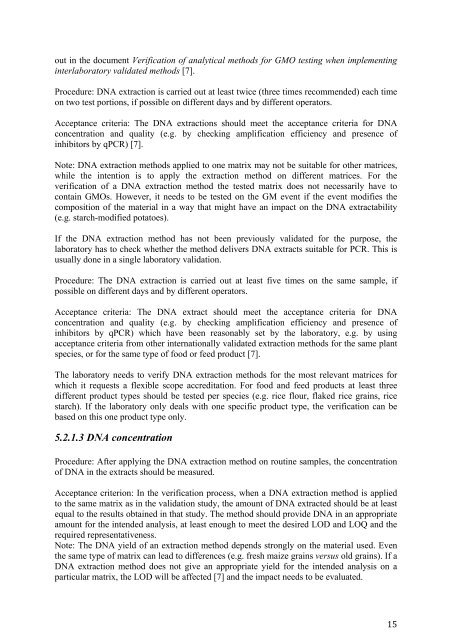final%20report%20online%20upd
final%20report%20online%20upd
final%20report%20online%20upd
You also want an ePaper? Increase the reach of your titles
YUMPU automatically turns print PDFs into web optimized ePapers that Google loves.
out in the document Verification of analytical methods for GMO testing when implementing<br />
interlaboratory validated methods [7].<br />
Procedure: DNA extraction is carried out at least twice (three times recommended) each time<br />
on two test portions, if possible on different days and by different operators.<br />
Acceptance criteria: The DNA extractions should meet the acceptance criteria for DNA<br />
concentration and quality (e.g. by checking amplification efficiency and presence of<br />
inhibitors by qPCR) [7].<br />
Note: DNA extraction methods applied to one matrix may not be suitable for other matrices,<br />
while the intention is to apply the extraction method on different matrices. For the<br />
verification of a DNA extraction method the tested matrix does not necessarily have to<br />
contain GMOs. However, it needs to be tested on the GM event if the event modifies the<br />
composition of the material in a way that might have an impact on the DNA extractability<br />
(e.g. starch-modified potatoes).<br />
If the DNA extraction method has not been previously validated for the purpose, the<br />
laboratory has to check whether the method delivers DNA extracts suitable for PCR. This is<br />
usually done in a single laboratory validation.<br />
Procedure: The DNA extraction is carried out at least five times on the same sample, if<br />
possible on different days and by different operators.<br />
Acceptance criteria: The DNA extract should meet the acceptance criteria for DNA<br />
concentration and quality (e.g. by checking amplification efficiency and presence of<br />
inhibitors by qPCR) which have been reasonably set by the laboratory, e.g. by using<br />
acceptance criteria from other internationally validated extraction methods for the same plant<br />
species, or for the same type of food or feed product [7].<br />
The laboratory needs to verify DNA extraction methods for the most relevant matrices for<br />
which it requests a flexible scope accreditation. For food and feed products at least three<br />
different product types should be tested per species (e.g. rice flour, flaked rice grains, rice<br />
starch). If the laboratory only deals with one specific product type, the verification can be<br />
based on this one product type only.<br />
5.2.1.3 DNA concentration<br />
Procedure: After applying the DNA extraction method on routine samples, the concentration<br />
of DNA in the extracts should be measured.<br />
Acceptance criterion: In the verification process, when a DNA extraction method is applied<br />
to the same matrix as in the validation study, the amount of DNA extracted should be at least<br />
equal to the results obtained in that study. The method should provide DNA in an appropriate<br />
amount for the intended analysis, at least enough to meet the desired LOD and LOQ and the<br />
required representativeness.<br />
Note: The DNA yield of an extraction method depends strongly on the material used. Even<br />
the same type of matrix can lead to differences (e.g. fresh maize grains versus old grains). If a<br />
DNA extraction method does not give an appropriate yield for the intended analysis on a<br />
particular matrix, the LOD will be affected [7] and the impact needs to be evaluated.<br />
15
















